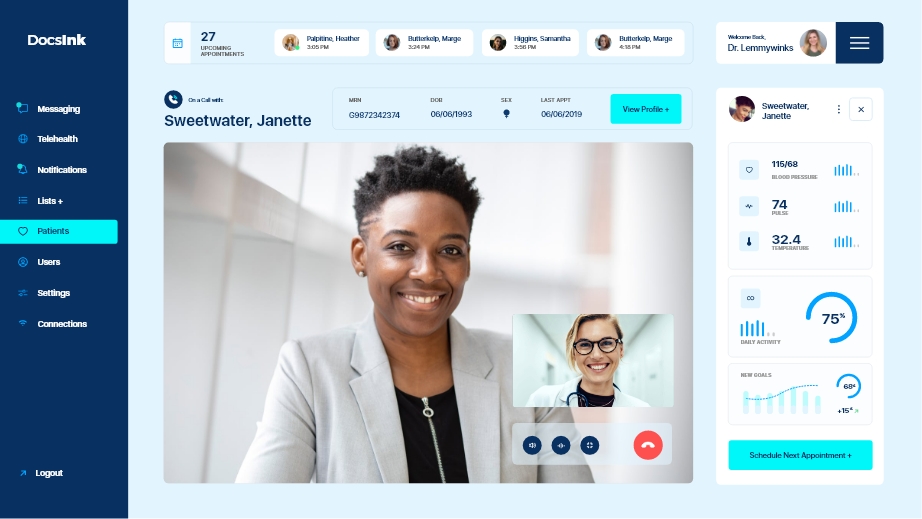Safeguard Remote Patient Monitoring Software: Securing Patient Data
Safeguard Remote Patient Monitoring Software: Securing Patient Data
Blog Article
The Future of Medical Care: Remote Client Monitoring Streamlined
As medical care proceeds to evolve, one area that holds immense pledge is remote client surveillance. The idea of streamlining this procedure with technical advancements is reshaping the way treatment is supplied and obtained. With a concentrate on boosting patient outcomes and streamlining healthcare distribution, remote tracking is positioned to revolutionize the industry. By discovering the advantages, technical technologies, and future trends in this area, we can obtain useful understandings right into the transformative capacity of remote person monitoring.
Advantages of Remote Client Tracking
Remote client tracking presents a wide variety of benefits for both healthcare carriers and patients alike. Additionally, remote client surveillance improves the general high quality of treatment by providing a more holistic and thorough view of clients' health and wellness standing beyond traditional in-person brows through.
Additionally, remote individual surveillance can lead to enhanced person outcomes and satisfaction. Remote tracking can minimize the requirement for regular healthcare facility sees, decreasing health care costs for both providers and patients.
Innovation Driving Remote Surveillance
In the realm of modern healthcare, technical developments play a pivotal role in driving the development and effectiveness of remote client tracking. The assimilation of cutting-edge technologies such as wearable tools, mobile applications, and cloud-based systems has actually changed the method healthcare service providers remotely monitor and take care of client health and wellness - software for remote patient monitoring. These modern technologies make it possible for continuous real-time surveillance of essential indicators, drug adherence, and other crucial health information, enabling prompt treatments and customized care strategies
One trick technology driving remote tracking is the Web of Things (IoT), which makes it possible for seamless connectivity in between clinical devices and health care systems. IoT tools such as smartwatches and cordless sensors accumulate and transfer client data to central systems, promoting remote monitoring from anywhere in the world. Artificial intelligence (AI) and artificial intelligence formulas better boost remote tracking by assessing large quantities of individual information to identify patterns, predict health and wellness patterns, and alert doctor to prospective issues.
Influence On Healthcare Delivery
With the assimilation of advanced innovations driving remote person monitoring, the effect on health care distribution is coming to be increasingly extensive and transformative. Remote person tracking enables doctor to use even more positive and individualized treatment to clients, leading to improved wellness outcomes and decreased hospital admissions. By remotely tracking vital signs, symptoms, and medication adherence, medical care specialists can step in early, stopping problems and boosting the general top quality of treatment.
In addition, remote monitoring boosts my link accessibility to medical care solutions, specifically for individuals in rural or underserved areas. Patients can obtain constant tracking and assistance from their homes, getting rid of the requirement for frequent in-person gos to. This not only saves time and reduces prices for both clients and health care centers yet also reduces the danger of direct exposure to infectious diseases, a vital consideration in the present health care landscape.
Furthermore, remote individual tracking makes it possible for doctor to far better designate resources and prioritize care based on real-time information. By determining high-risk people and intervening immediately, medical care distribution comes to be much more reliable and efficient, ultimately bring about a much more lasting and patient-centered health care system.
Improving Client Results

In addition, RPM permits for positive administration of persistent problems, reducing the probability of intense exacerbations and healthcare facility readmissions. Clients take advantage of enhanced ease and comfort, as they can get treatment in their very own homes while remaining connected to their healthcare suppliers. This continual tracking not just enhances patient fulfillment yet likewise promotes a sense of empowerment and engagement in their own health and this hyperlink wellness monitoring.
Future Trends in Remote Surveillance
Embracing cutting-edge technologies in remote individual surveillance is forming the future landscape of health care delivery. One considerable trend is the enhanced use of wearable tools and sensors to collect real-time information, making it possible for medical care service providers to monitor patients constantly without the need for regular in-person check outs.

Additionally, telehealth platforms are becoming extra innovative, enabling digital appointments, remote medical diagnosis, and remote patient monitoring done in one integrated system (remote patient monitoring platform). This all natural method to remote tracking is improving healthcare shipment, boosting client satisfaction, and ultimately, boosting general quality of care
Conclusion
To conclude, remote client tracking provides various have a peek at these guys advantages in health care delivery, driven by developments in innovation. It has the prospective to enhance individual results and transform the method healthcare is delivered. Future patterns in remote monitoring will remain to form the landscape of healthcare, offering chances for even more customized and efficient individual treatment.
Remote person monitoring presents a wide variety of advantages for both health care carriers and patients alike. In addition, remote individual monitoring enhances the overall quality of care by giving a more thorough and all natural view of clients' health condition past traditional in-person check outs.
Additionally, remote client surveillance can lead to enhanced client outcomes and contentment. Remote individual surveillance enables healthcare suppliers to supply even more tailored and proactive treatment to people, leading to improved wellness outcomes and reduced medical facility admissions. Remote person surveillance (RPM) plays a considerable function in improving patient outcomes by offering constant, real-time information that makes it possible for health care companies to step in immediately and change treatment strategies as needed.
Report this page